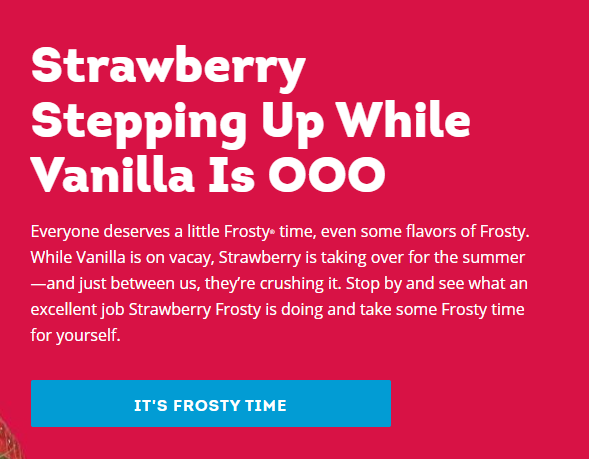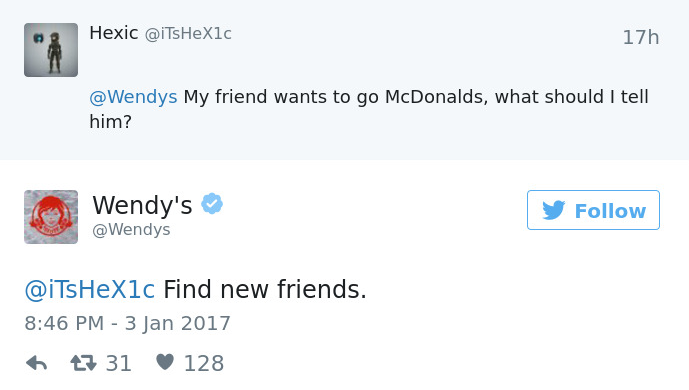Imagine this: It’s 2017, and you’re a bold young social media enthusiast who just got a job at Wendy’s. The fast-food chain needs a social content campaign that’s always fresh and never frozen (just like the beef). How can you translate burgers and fries into one of the biggest social media trends?
“Well,” you think to yourself, “I’m good at roasting strangers on the internet, so let me give that a try.”
5 years later, you’re running #NationalRoastDay from a standout account on Twitter. Rival fast-food chains, other brands, even innocent bystanders — no one is safe from your roasting rampage, and your social media followers are eating it up. (Pun totally intended.)
Okay, so I don’t know if that’s how it happened, but I do know this is a great example of how powerful a social media strategist can be. A social media strategist is the person who runs your brand’s accounts, comes up with campaign strategies, manages content calendars and, occasionally, roasts your competition on Twitter.
Here’s everything you need to know about this critical role in digital marketing!

What a Social Media Strategist Looks Like
Like all marketing geniuses, social media strategists come in all shapes and sizes. There’s no specific person who fits the job description, which is part of what makes social media marketing (and marketing in general) such a diverse and fascinating field.
However, these folks do tend to have a few things in common — a very particular set of skills, if you will. Of course, that set of skills is probably not the same as Liam Neeson’s in “Taken,” but it’s impressive nonetheless.
Here are 5 things that define a social media strategist:
1. A Passion for Social Media
This one might seem a bit on the nose, but it’s a big deal. That’s because a social media strategist needs to understand what makes each platform unique — and, perhaps more importantly, how to utilize those elements to make your marketing content stand out. If you’re flustered by Facebook, taken aback by TikTok or stumped by Snapchat, you probably won’t have fun trying to come up with strategies to navigate all those networks and more.
2. An Analytical Mind
On the surface, you might not realize how much of social media strategy is determined by data, measurements and problem-solving. In reality, analysis is the name of the game — and without it, a social media strategist would be forced to make guesses about which trends to follow, what audience to speak to and how to create a solid campaign. From dissecting competitors’ TikTok ads to measuring conversion rates and reach, having the right data makes all the difference. That’s why these folks bring their sharp analytical minds to work every day.
3. Top-Notch Communication Skills
Social media is all about communication. In fact, it’s communication on a grander scale than anything the world has seen before: More than 4 billion people use social media across the globe, each spending roughly 2.5 hours a day browsing an average of 7 different platforms. Just think of all those connections.
With so many of these interactions happening 24/7, there are all kinds of things to think about, from rapidly shifting meme trends to increasing privacy expectations. Luckily, a social media strategist has the skills necessary to navigate these new communication rules and make real connections, even if they only have 280 characters to make it happen.
4. A Collaborative Nature
I know what you’re thinking: “Aren’t communication and collaboration kind of the same thing?”
Well, yes and no. Communication is about exchanging information, which is vital for collaboration. However, you can exchange information every second for the rest of your life and still get nowhere if you’re not aligning your goals and perspectives with the people around you. That’s what makes collaboration special.
A social media strategist knows this better than almost anyone. That’s because these experts need to communicate and collaborate to build campaigns that reflect the needs of the entire company and still create a memorable experience for social media followers. For this reason, a social media strategist is often a social problem-solver, a cooperative worker and an eager team player.
5. The Ability to Tell a Good Story
At the end of the day, social media is all about storytelling. Take Wendy’s and their roasts, for example. When you see their activity on Twitter, their story is clear: “We aren’t just a fast-food chain. We have personality and attitude, and we’re bringing you into our world to have a little fun.”
In this way, a social media strategist needs many of the same skills as the bards and minstrels of old:
- A keen sense of character.
- A knack for capturing and creating emotion.
- An instinct for dramatic tension, irony and other storytelling tools.
- The ability to read the audience and understand their expectations.
- The confidence to build a personality around something as simple as burgers and fries.
The Roles and Responsibilities of a Social Media Strategist
Each one may look like the cheeky jabs of an everyday person, but you can bet that every Wendy’s roast is a carefully thought-out part of the brand’s Twitter campaign — a way to boost engagement among followers and turn marketing content into the topic of household conversation. The people responsible for that strategy have to think about brand awareness, social media trends, target audience and more. It’s all just a day in the life of a social media strategist.
Here are a few key roles and responsibilities that fall into the job description:
Developing a Social Media Strategy for Every Platform
Here’s the thing: What works on Twitter isn’t necessarily going to fly on Facebook, and what your TikTok followers want is not the same as what Pinterest users are looking for. That means a social media strategist must come up with a unique strategy for every platform you use. On top of that, they need to build an overall social media approach that maintains your brand story and voice (even if the approach changes between channels).
When creating these frameworks, a social media strategist must consider things like:
- Media type: Are you communicating through images like on Instagram, or videos like on TikTok? Media type shapes and informs the stories you can tell on each social media channel, which means it’s a vital consideration for social media strategists.
- Audience demographics: Age, geographical location, occupation, income level — these key demographics help a social media strategist understand whom they’re speaking to and how those audiences shift across platforms.
- Current trends: Did you know that some estimates say the lifespan of a meme is only 4 months? Social media trends go out of style almost as fast as updog. (This is the part where you say, “What’s updog?” And I say, “Not much, what’s up with you?”) That means a social media strategist has to keep up with audience preferences to avoid making outdated jokes or references, which is what the kids call “cringe.”
Identifying Key Performance Indicators
Key performance indicators, or KPIs, are the metrics you use to measure the performance of your social media campaign. KPIs are determined based on your definition of success and can shift between each social media campaign.
For example, say you want your brand to become a household name. That means brand awareness would be one of your KPIs. A social media strategist would take this information exporting Instagram analytics or from other platforms and build a campaign around buzzworthy content — like Wendy’s roasts. (Hint: They generally do this in concert with a content marketing strategist, who helps develop and execute content tactics.)
Here are some examples of other KPIs for social media marketing:
- Net promoter score (NPS).
- Customer lifetime value (CLV).
- Follower count.
- Qualified leads.
- Conversions.
- Sales.
Leveraging Your Brand Voice
Brand voice is the way your content “sounds” to your audience. Some companies want to sound professional and formal, while others want to use internet slang and roast their competition. Different strokes for different folks, right?
You probably already have your brand voice figured out — at least partially. It’s the tone you use for landing pages, email marketing, product descriptions and more. However, because every social media platform has its own rules, community and expectations, you’ll have to change things up a little. Your Twitter voice can’t be exactly the same as your landing page voice.
Of course, you still have to be consistent enough to create a cohesive experience for an audience that is likely to interact with your brand across multiple channels. A social media strategist makes this possible by keeping track of your brand voice in all its forms. They also know how to leverage that voice in different ways depending on the medium — like using meme images in social media posts but using written slang on more text-heavy channels like landing pages.
Here’s an example of how Wendy’s remains fun and cheeky across all audience touchpoints but switches up its approach:
Landing Page Content:

Tweet Content:
When adding milk makes you taste better, you’re doing it wrong. #NationalRoastDay
— Wendy’s (@Wendys) January 12, 2022
Communicating With Followers
Most social media networks aren’t designed for one-way communication. Instead, the key to true audience engagement and an unforgettable customer experience is to respond to the community. This doesn’t just make your company seem approachable — it creates memorable moments, connections and interactions, allowing you to feed off of and encourage your audience’s interest in your content.
A lot of this back-and-forth can fill practical needs, like answering product questions or boosting positive feedback. However, it can also give you room for more personalized interactions — like gently roasting your audience when they choose the competition. You also have the opportunity to engage in industry-wide conversations, teaming up with other brands to discuss key topics or, of course, start a rap battle like the one between Wendy’s and Wingstop.
Speaking of Wendy’s, here are 2 examples of top-notch responses from the chain:
Responding to Followers:

Responding to the Competition:
Somehow not the worst clown based fast food restaurant.#NationalRoastDay
— Wendy’s (@Wendys) January 12, 2022
Monitoring Brand Reputation
Let’s say you’re not Wendy’s (which you probably aren’t). You have a unique social media strategy and a voice all your own, both of which are key to a formal, professional reputation among followers.
Then you decide to pull a Wendy’s, roasting a customer in a social media post.
Remember, this hasn’t been part of your brand voice up until now — so your audience might see this as a 180-degree turn. They could start interpreting your content as disingenuous, inconsistent or mean, and they might even label you with the dreaded “trying too hard.”
You’ve just shifted out of your established voice, and your brand is likely to be impacted.
There’s good news, though: A social media strategist can help you avoid these embarrassing incidents. By monitoring your brand’s reputation through mentions, comments, audience engagement and more, a social media strategist learns how your audience sees you. With this information in mind, they can make the right moves to stay “in character.” That means you can avoid taking customers out of your brand story with an ill-phrased Tweet or an insensitive reply, all because you know what you mean to your audience and how to continue portraying that image.
On the other hand, reputation monitoring can also help you change up your strategy or even reinvent your brand voice. Wendy’s wasn’t always the queen of roasts, which goes to show that change can be good if you base it on your audience’s expectations, social media trends and more. (You should also consider doing this gradually or having a “rebrand announcement,” but that’s a blog post for a different time.)
Uniting Marketing Experts of All Kinds
Social media is really a collaborative effort. Think about all the things that go into a single post: search engine optimization efforts, content creation, graphic design — the list goes on. That means a social media strategist must be able to unite marketing experts across all disciplines to create something that will earn likes, shares and comments from followers.
The key, according to our own is to know what people need. That doesn’t just mean consumers — a true strategist should understand the perspectives of copywriters, SEO experts, animators, graphic designers, sales teams and more. It’s all about finding a shared language, and for many marketing experts, that language is storytelling.
Why You Need a Social Media Strategist
So, now that you know what a social media strategist looks like and what they do, why do you need one on your team? Here are just a few good reasons:
- There’s a lot to keep up with: Social media trends are always changing, and so are the platforms themselves. Without a dedicated social media expert, you probably won’t be able to keep up with everything — if you even want to. (Some of us are perfectly happy with one meticulously maintained Pinterest account, thank you very much.)
- Your brand needs to stand out: Remember when we said more than 4 billion people use social media? Imagine if all of those people posted just once per day. That’s 4 billion posts competing for your audience’s competition. A social media strategist can help you stand out from the crowd, giving you a chance to occupy space on a user’s social media feed and in their minds.
- Social media is all about consistency: Have you ever been researching a brand on your favorite social media channel, only to realize they haven’t posted in months or even years? Your audience expects you to be consistently present on social media — not just when you attend an industry event or launch a new product. That means it’s helpful to have a social media strategist who can help you decide what to say (even when it seems like there’s nothing to say at all).
- Other marketing experts might not have all the answers: Although social media marketing is an ode to collaborative storytelling, it can’t be done by just anyone. For example, put a content writer in charge of your social media and they might end up penning Facebook essays, while a graphic designer could get so caught up in the art that they forget to use even a single word. Neither approach works independently, which is why you need a social media strategist (or even a social media manager) to help bring everyone together.
Facebook, Twitter, TikTok — Oh My!
The thing about social media marketing is that we can’t all be Wendy’s. As much fun as it would be to turn your entire social media strategy into one big roast, you probably couldn’t get away with it (not least because the Wendy’s Twitter account would probably come after you).
The good news is that, with a social media strategist on your side, there are plenty of other ways to navigate the wide and wonderful world of social networking. Even if you shudder at the thought of Facebook, Twitter, TikTok and all their friends, a social media strategist has your back.
In the meantime, remember there’s always a fun new social media trend to catch up on — so subscribe to our newsletter to get them all delivered right to your inbox.
Now if you’ll excuse me, I need to go figure out what happens when you click on this Wendy’s CTA:






